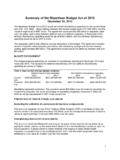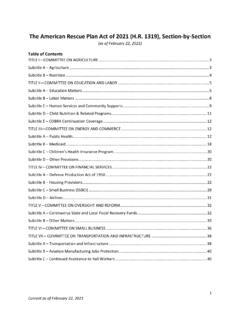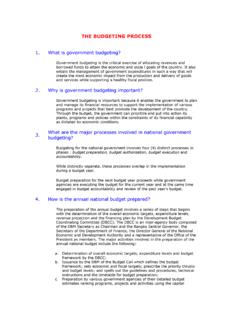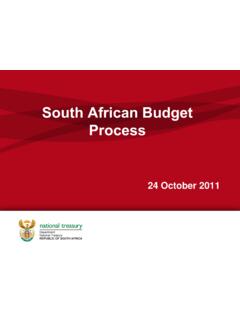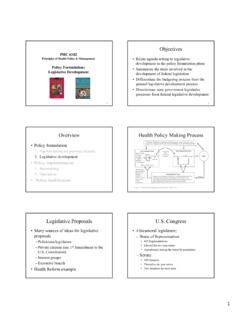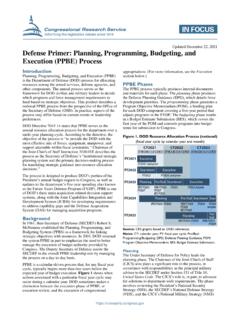Transcription of The Congressional Budget Process: A Brief Overview
1 CRS Report for CongressPrepared for Members and Committees of Congress The Congressional Budget process : A Brief Overview James V. Saturno Section Research Manager August 22, 2011 Congressional Research Service 7-5700 RS20095 The Congressional Budget process : A Brief Overview Congressional Research Service Summary The term Budget process , when applied to the federal government, actually refers to a number of processes that have evolved separately and that occur with varying degrees of coordination. This Overview , and the accompanying flow chart, are intended to describe in Brief each of the parts of the Budget process that involve Congress, clarify the role played by each, and explain how they operate together.
2 They include the President s Budget submission, the Budget resolution, reconciliation, sequestration, authorizations, and appropriations. This report will be updated to reflect any changes in the Budget process . The Congressional Budget process : A Brief Overview Congressional Research Service Contents The Basic Framework .. 1 The Budget Cycle .. 1 The Budget Resolution and Reconciliation .. 2 The Appropriations process .. 3 Revenue and Public Debt 3 Budget Enforcement and Figures Figure 1. The Congressional Budget process : Timetable for Annual Action .. 6 Contacts Author Contact 7 The Congressional Budget process : A Brief Overview Congressional Research Service 1 The Basic Framework The Constitution grants the power of the purse to Congress,1 but does not establish any specific procedure for the consideration of budgetary legislation.
3 Instead, a number of laws and Congressional rules contribute to the federal Budget process , with two statutes in particular forming the basic The Budget and Accounting Act of 1921, as codified in Title 31 of the United States Code, established the statutory basis for an executive Budget process by requiring the President to submit to Congress annually a proposed Budget for the federal government. It also created the Bureau of the Budget (reorganized as the Office of Management and Budget (OMB) in 1970) to assist him in carrying out his responsibilities, and the General Accounting Office (GAO, renamed the Government Accountability Office in 2004) to assist Congress as the principal auditing agency of the federal government.
4 The Congressional Budget and Impoundment Control Act of 1974 ( 93-344, 88 Stat. 297) established the statutory basis for a Congressional Budget process , and provided for the annual adoption of a concurrent resolution on the Budget as a mechanism for facilitating Congressional budgetary decision making. It also established the House and Senate Budget Committees, and created the Congressional Budget Office (CBO) to provide budgetary information to Congress independent of the executive branch. The Budget Cycle The President is required to submit to Congress a proposed Budget by the first Monday in February. Although this Budget does not have the force of law, it is a comprehensive examination of federal revenues and spending, including any initiatives recommended by the President, and is the start of extensive interaction with Congress.
5 Within six weeks of the President s Budget submission, Congressional committees are required to submit their views and estimates of spending and revenues within their respective jurisdictions to the House and Senate Budget Committees. These views and estimates, along with information from other sources, are then used by each Budget Committee in drafting and reporting a concurrent resolution on the Budget to its respective house. Other information is gathered by the Budget Committees in reports and hearing testimony. That information includes Budget and economic projections, programmatic information, and Budget priorities, and comes from a variety of sources, such as CBO, OMB, the Federal Reserve, executive branch agencies, and Congressional leadership.
6 1 Article I, Section 8 provides that The Congress shall have Power To lay and collect Taxes, Duties, Imposts and Excises, and Section 9 provides that No Money shall be drawn from the Treasury, but in Consequence of Appropriations made by Law. 2 For a more extensive Overview of the federal Budget process , see CRS Report 98-721, Introduction to the Federal Budget process , coordinated by Bill Heniff Jr. The Congressional Budget process : A Brief Overview Congressional Research Service 2 Although it also does not have the force of law, the Budget resolution is a central part of the Budget process in Congress. As a concurrent resolution, it represents an agreement between the House and Senate that establishes Budget priorities, and defines the parameters for all subsequent budgetary actions.
7 The spending, revenue, and public debt legislation necessary to implement decisions agreed to in the Budget resolution are subsequently enacted separately. Discretionary spending,3 in the form of appropriation bills, involves annual actions that must be completed before the beginning of a new fiscal year on October 1. Changes in direct spending4 or revenue laws may also be a part of budgetary actions in any given year. When these changes are directly tied to implementing the fiscal policies in the Budget resolution for that year, the reconciliation process may be used. Reconciliation typically follows a timetable established in the Budget resolution. Other budgetary legislation, such as changes in direct spending or revenue laws separate from the reconciliation process , changes in the public debt limit, or authorizing legislation, are not tied directly to the annual Budget cycle.
8 However, such legislation may be a necessary part of budgetary actions in any given year. The Budget Resolution and Reconciliation The Budget resolution represents an agreement between the House and Senate concerning the overall size of the federal Budget , and the general composition of the Budget in terms of functional categories. The amounts in functional categories are translated into allocations to each committee with jurisdiction over spending in a process called crosswalking under Section 302(a) of the Congressional Budget Act. Legislation considered by the House and Senate must be consistent with these allocations, as well as with the aggregate levels of spending and revenues. Both the allocations and aggregates are enforceable through points of order that may be made during House or Senate floor consideration of such legislation.
9 These allocations are supplemented by nonbinding assumptions concerning the substance of possible budgetary legislation that are included in the reports from the Budget Committees that accompany the Budget resolution in each house. In some years, the Budget resolution includes reconciliation instructions. Reconciliation instructions identify the committees that must recommend changes in laws affecting revenues or direct spending programs within their jurisdiction in order to implement the priorities agreed to in the Budget All committees receiving such instructions must submit recommended legislative language to the Budget Committee in their respective chamber, which packages the recommended language as an omnibus measure and reports the measure without substantive revision.
10 A reconciliation bill would then be considered, and possibly amended, by the full House or Senate. In the House, reconciliation bills are typically considered under the terms of a special rule. In the Senate, reconciliation bills are considered under limitations imposed by Sections 305, 310, and 313 of the Congressional Budget Act. These sections limit debate on a reconciliation bill to 20 hours, and limit the types of amendments that may be considered. 3 Discretionary spending is that spending not mandated by existing law, and therefore is made available in such amounts as Congress chooses through the appropriations process .


